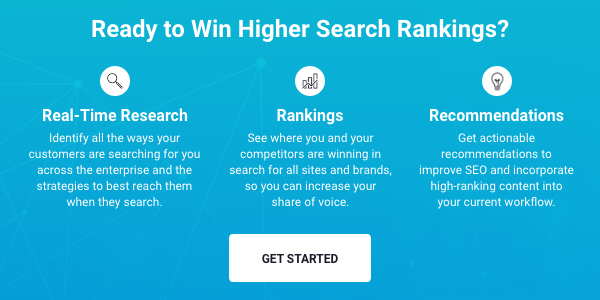Search for guides about measuring the success of your search engine optimization (SEO) strategy and you’ll be met with an array of what are, in effect, glossaries—lists of metrics and accompanying definitions. Unfortunately, there’s very little information about organizing those metrics into an effective plan.
In order to track your SEO activities in a valuable and sustainable way, you need to organize metrics into a broader long-term plan. What’s more, it’s crucial to leverage the right digital tools, preferably in a platform that allows you to manage data effectively and scale your strategy.
This post will show you how to craft a high-level SEO measurement strategy. We’ll also demonstrate how SEO tools strengthen reporting processes, with examples from BrightEdge, a software solution that provides dozens of features in a comprehensive enterprise SEO platform.
1. Choose Key Performance Indicators (KPIs)
A relevant selection of SEO metrics forms the foundation of a strategy that drives ongoing improvements to rankings.
However, it’s essential to remember that your chosen metrics should reflect the broader consensus about which outcomes are important within your business. Linking SEO targets to more general digital and organizational goals ensures they support the bigger picture.
When choosing KPIs, metric “glossaries” are helpful. Determine which metrics are meaningful in the context of your search strategy and high-level goals and use them as the basis for your reporting. If you’re in a growth phase and want to reach more audiences, focus on methods that reflect that. If you’re currently trying to improve the conversion process on your site, perhaps focus on site engagement through organic search and apply resources towards on-page.
Typically, the following metrics will be applicable: rankings, search traffic, organic conversions, engagement, and to a lesser extent, backlinks. That said, every company will have its own mix that mirrors its unique goals.
Example: BrightEdge Keyword Reporting and Instant
Keyword Reporting and Instant are BrightEdge’s main rank-tracking tools. They generate reports over specified periods of weeks and months and on a daily basis.
Rank tracking is the bread and butter of SEO measurement, and fuels content creation and optimization of existing pages, among other things.
Keyword Reporting and Instant provide the following functionality:
- Keyword Reporting is an example of a dedicated feature that provides insights into keyword-focused ranking improvements and fluctuations. Reports are generated for specified periods and filtered based on device, location, search engine, and more.
- Keyword Reporting also provides data related to organic impressions, clicks and traffic.
- Instant provides real-time information about mobile and desktop rankings, across multiple locations and languages, thus giving an up-to-date picture of a site’s current keyword status. Instant also incorporates ranking information from search engines like YouTube and Amazon in addition to Google.
2. Establish Metric-Based Targets
Once you have identified which metrics are important within your organization, use them to create tangible goals.
Setting goals is tricky. In SEO, many variables can’t be fully manipulated. These include competitor activity, market share, and available resources for off-page optimization. Therefore, building a degree of flexibility into targets in these areas is essential.
On the other hand, some aspects of SEO can be controlled. These include website optimization, indexation in search engines, and content creation. Goals relating to these activities can be more definite.
Having clear goals is also beneficial from a strategic standpoint. Highlighting a single central metric—or a small handful of metrics—that adequately encompasses the bulk of your SEO efforts provides a tangible performance barometer for stakeholders.
Often, high-level individuals will not be interested in the minutiae of their organization’s SEO strategy, and you might find eyes glazing over if you start elaborating on the formulas underpinning custom KPIs. Simplifying your important metrics makes show-and-telling the SEO story easier.
Example: BrightEdge SEO Dashboards
BrightEdge’s Storybuilder is our data visualization tool for dashboarding, and is used for generating insights, presenting search-related activity, and making forecasts.
It has the following core features:
- StoryBuilder enables SEOs to present search improvements in an understandable way, often by amalgamating various metrics. This provides flexibility in reporting and allows users to include the data that matters most to their organization, which is very important.
- Progress can be framed in terms of specific questions like “Are we getting more organic visits?” and “Are conversions increasing?”. This helps stakeholders visualize complex data sets, particularly in the context of traffic, conversions and sales.
3. Set a Viable Reporting Cadence
There are two categories of SEO metrics: those tracked within an SEO department for managing daily tasks and those used to brief stakeholders.
Be clear about how often in-depth reports will be published and distributed within your organization. This may also apply to briefs about what’s happening in the search landscape.
Equally, it’s important to clarify which metrics you require to monitor day-to-day tasks. For example, SEOs often check Google Search Console daily for information about crawlability and indexability on their websites. Additionally, weekly technical crawls during off-peak hours is a good way to stay up to date with website health.
It’s also crucial to manage stakeholder expectations. Agree on goals and KPIs from the very beginning, so when you report on them in the future you’re all on the same journey. And recognize that SEO metrics should be differentiated from marketing metrics when they incorporate financial data. Typically, stakeholders are interested in the bottom line, as opposed to indicators like share of voice, keyword rankings, quality of backlinks, and so on. And SEOs may not be able to provide this information directly, because organic search often has a big footprint in most attribution models.
Example: BrightEdge Daily Pulse and Data Cube
Daily Pulse and Data Cube provide up-to-date SEO health metrics that can be organized into understandable visual presentations for stakeholders.
The tools provide the following features:
- Pulse provides a daily overview of SEO activity. Metrics include an average keyword ranking, organic traffic, and ranking fluctuations. This information is helpful for both SEO departments and stakeholders in an organization looking for a digestible up-to-date snapshot.
- Data Cube provides a long-term overview of content performance in terms of aggregate scores like total pages ranked in the top ten results on Google. Identifying trends usually takes a long time, and clear visualizations are essential for forecasting potential changes.
4. Tie Rankings to Conversions and Return on Investment (ROI)
Tying rankings to conversions, and reporting on these regularly, is the best way to determine your SEO strategy's overall success
Ultimately, SEO is undertaken with a view to generating leads and driving revenue. All SEO activities, and the role of corresponding performance metrics, are geared towards this end, even if indirectly (there are corner cases where the goal isn’t revenue, like visibility or brand awareness).
The overall success of an SEO program is dependent on being able to attribute results to individual strategies. To do this, you need to correlate search ranking changes with engagement, conversions, sales, and revenue.
This might be hard to do using different softwares and trying to stitch together a story. A fully integrated software suite will enable you to connect organic traffic with conversions and compare the effectiveness of different marketing channels.
Example: BrightEdge Site Report
Site Report is one of BrightEdge’s central reporting dashboards and is used to link SEO to various bottom-line metrics.
Site Report provides the following features:
- Tracking of revenue and sales from organic channels.
- Ranking overviews of indexed pages and keyword groups compared to competitors.
- Reports of clicks and impressions from organic site visitors.
- Comparisons of the performance of different digital channels, like social media and paid ads.
5. Monitor Competitor Activity
Measuring the activity of competitors is one of the best ways to determine the relative effectiveness of your SEO strategy. It will also ensure that you remain aware of tactics and practices that have been overlooked, particularly when adjusting to account for missing keywords and newly introduced on-page techniques.
It is easy for SEOs to fall into the trap of assuming that they have covered all the bases, especially if they own a large share of the market, and become apathetic as a consequence. Monitoring competitors helps maintain humility within SEO departments and protects against overconfidence. There are a lot of competitive SEO tools that help identify who is who, but we’ll use one of our products in our platform to show you how we do it.
Example: BrightEdge Share of Voice
Share of Voice is BrightEdge’s tool for monitoring overall market share and presence. Share of Voice is a valuable aggregate metric for tracking comparative performance.
Share of Voice provides the following functionality:
- Tracking of competitor performance for keyword groups and measurement of your site’s share of voice.
- Insights about competitor SEO activity like backlink strategies and on-page optimization.
- Tracking of goals related to market presence. For example, if you own 10% of all keywords relevant to a certain product, you may set a goal to increase your share to 15%. Your progress can be measured using Share of Voice features.
Conclusion
SEO measurement is about more than picking a handful of metrics and publishing monthly reports. It should tie in with your overall marketing and business goals. SEO that exists in a silo cannot be sustained over the long term, and to have an effective strategy you need to collaborate with other functions of the business including content, UX, engineering and more.
Similarly, it is vital to measure both positive and negative changes. Doing so allows you to identify where to allocate resources. SEOs often have a tendency to report exclusively on the good things, but in reality it’s the shortcomings that help you outline “what’s next?”.
Moreover, tools are critical when putting together an infrastructure that enables you to track all your SEO processes. And as discussed throughout this article, there are pain points in point solutions that can be overcome by using an enterprise SEO platform to help manage and govern your strategy.
With all that in mind, it’s probably time to start thinking about those all-important KPIs. Perhaps a cup of coffee first, though?
More Resources
- The SEO Metrics That Matter Most
- Backlink Strategies
- 11 SEO Myths That Will Damage Your Rankings in 2022


